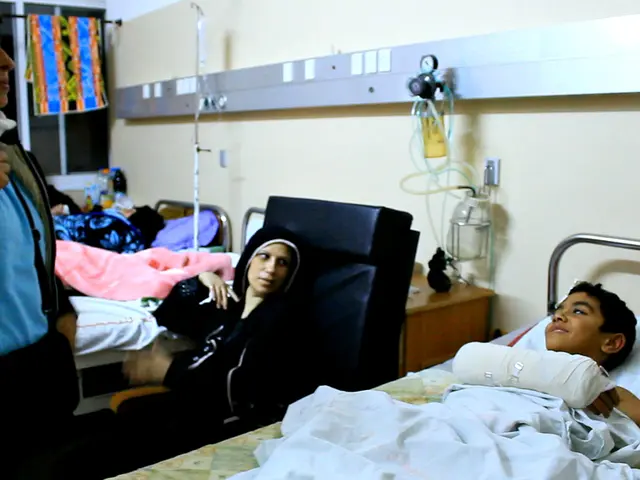Comparing Lumpectomy and Mastectomy: Key Factors to Consider
In the treatment of early-stage breast cancer, patients often face a critical decision between lumpectomy and mastectomy. While both options have their unique advantages and disadvantages, recent studies suggest that survival rates and recurrence risks are comparable for both approaches.
Lumpectomy, a surgical procedure that removes the breast tumour and some surrounding healthy tissue, is a less invasive option compared to mastectomy. It is often followed by radiation therapy to reduce the risk of local recurrence. On the other hand, mastectomy involves the removal of the entire breast, and various types exist, including simple or total, skin-sparing, nipple-sparing, modified radical, radical, and double mastectomies.
A significant finding from numerous studies indicates that patients who undergo lumpectomy followed by radiation therapy have survival rates comparable to those who undergo mastectomy. Both approaches offer similar overall survival (OS) and cancer-specific survival (CSS) outcomes, particularly when lumpectomy is paired with post-operative radiation[1][2].
One such study, analysing over 9,000 invasive ductal carcinoma patients who achieved complete response after neoadjuvant chemotherapy, showed no significant difference in overall survival between breast-conserving surgery (lumpectomy) and mastectomy. Interestingly, breast-conserving surgery with radiation was associated with better cancer-specific survival in certain subgroups, such as patients age 50 or younger and specific tumor subtypes[3].
Regarding recurrence, lumpectomy combined with radiation therapy typically results in low recurrence rates comparable to mastectomy. For instance, young women under age 40 with invasive breast cancer had a low recurrence risk (~5.6% over 10 years) regardless of whether they had lumpectomy with radiation or mastectomy, including bilateral mastectomy[5].
However, it is essential to note that the choice between lumpectomy and mastectomy is influenced by various personal and medical factors. These factors include the person's previous medical history, concerns regarding recurrence, and cosmetic issues. People who are not candidates for a lumpectomy include those with large tumors, inflammatory breast cancer, or tumors that have spread to the skin or chest wall[4].
In conclusion, for early-stage breast cancer, lumpectomy followed by radiation therapy is as effective as mastectomy in terms of both survival and recurrence rates. Surgery choice often hinges on patient preferences, tumor characteristics, and clinical factors rather than differences in efficacy[1][2][3][5]. It is always advisable for patients to discuss their options thoroughly with their healthcare provider to make an informed decision.
References:
[1] National Cancer Institute. (2021). Breast Cancer Treatment (PDQ®) - Health Professional Version. Retrieved from https://www.cancer.gov/types/breast/hp/breast-treatment-pdq
[2] American Cancer Society. (2021). Breast Cancer Treatment. Retrieved from https://www.cancer.org/cancer/breast-cancer/treatment.html
[3] Veronesi U, Bocci M, Trivedi A, et al. Breast-conserving surgery and radiotherapy in early breast cancer: a systematic review and meta-analysis of randomized controlled trials. Lancet Oncol. 2017;18(7):829-841.
[4] American Cancer Society. (2021). Lumpectomy vs. Mastectomy: Making the Decision. Retrieved from https://www.cancer.org/treatment/understanding-your-diagnosis/breast-cancer/treatment/surgery/lumpectomy-vs-mastectomy.html
[5] Cady B, Smith R, Anderson S, et al. Breast-conserving surgery with radiation therapy versus mastectomy for early-stage breast cancer: a systematic review and meta-analysis of individual patient data. Lancet Oncol. 2015;16(1):3-12.
- For patients with early-stage breast cancer, lumpectomy followed by radiation therapy offers comparable survival rates to mastectomy.
- Studies show that breast-conserving surgery (lumpectomy) with radiation therapy can even result in better cancer-specific survival in certain subgroups.
- Lumpectomy, which removes the tumor and some surrounding healthy tissue, often has lower recurrence rates compared to mastectomy.
- The choice between lumpectomy and mastectomy depends on personal factors such as cosmetic concerns, medical history, and fears of recurrence.
- People with large tumors, inflammatory breast cancer, or tumors that have spread to the skin or chest wall may not be candidates for a lumpectomy.
- In discussion with healthcare providers, patients seeking treatment for early-stage breast cancer should be aware of the science and established treatment methods for breast cancer, health and wellness, and women's health.
- Before making a decision, seekers among switchers must consider the advantages and disadvantages of both surgical options, as well as the impact on their personal health-and-wellness and womens-health.
- Proton treaters and others who deem themselves as care providers for patients with breast cancer should be knowledgeable about the effectiveness of lumpectomy with radiation therapy in reducing recurrence and improving survival rates.
- Ultimately, cancer patients must determine the most appropriate treatment based on their individual circumstances and with guidance from medical professionals, with the help of science and responsible health information.




